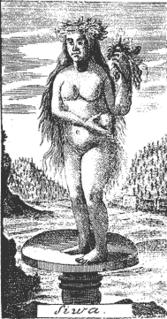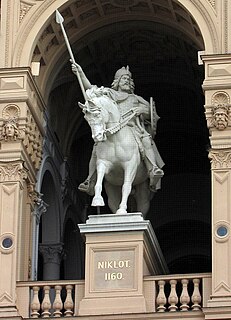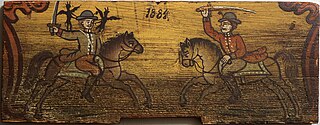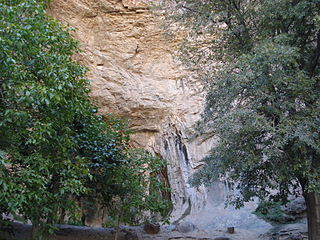In Norse mythology, Ginnungagap is the primordial void, mentioned in the Gylfaginning, the Eddaic text recording Norse cosmogony.

In Greek mythology, Phorcys or Phorcus is a primordial sea god, generally cited as the son of Pontus and Gaia (Earth). According to the Orphic hymns, Phorcys, Cronus and Rhea were the eldest offspring of Oceanus and Tethys. Classical scholar Karl Kerenyi conflated Phorcys with the similar sea gods Nereus and Proteus. His wife was Ceto, and he is most notable in myth for fathering by Ceto a host of monstrous children. In extant Hellenistic-Roman mosaics, Phorcys was depicted as a fish-tailed merman with crab-claw forelegs and red, spiky skin.

Mokosh is a Slavic goddess mentioned in the Primary Chronicle, protector of women's work and women's destiny. She watches over spinning and weaving, shearing of sheep, and protects women in childbirth. Mokosh is the Mother Goddess.

Živa, also Živena, Żiwia, Siva, Sieba or Razivia, is the Slavic goddess of life and fertility. She was worshiped throughout what is now Poland, the Czech Republic, Slovakia, Slovenia and Germany, before Christianity expanded into the area. Her name means "living, being, existing". Živa is mentioned in The Baptism on the Savica, an epic-lyric poem by the Slovene national poet France Prešeren.
In German folklore, the figure of the Freischütz is a marksman who, by a contract with the devil, has obtained a certain number of bullets destined to hit without fail whatever object he wishes. As the legend is usually told, six of the magic bullets, are thus subservient to the marksman's will, but the seventh is at the absolute disposal of the devil himself.
A krsnik or kresnik is a type of vampire hunter, a shaman whose spirit wanders from the body in the form of an animal. The krsnik turns into an animal at night to fight off the kudlak, his evil vampire antithesis, with the krsnik appearing as a white animal and the kudlak as a black one. The krsnik 's soul leaves the body, either voluntarily or due to a higher power, to fight evil agents and ensure good harvest, health, and happiness.
Jan Novák was a Czech composer of classical music. Novák was primarily active in the 1960s and composed the music for several films of Karel Kachyňa. Novák also composed music for the films of animators Jiří Trnka and Karel Zeman, the leading figures of the Czech animated film, as well as for Wir.

Thomas Gale was an English classical scholar, antiquarian and cleric.
Theologia mythologica is a 1532 book by Georg Pictorius. It was one of the first treatises of Classical mythology in the German Renaissance. Pictorius interprets the Greek pantheon as allegory, e.g. Cybele as the Earth, her chariot wheels as symbolizing the rotation of the Earth.

Niklot or Nyklot was a chief or prince of the Slavic Obotrites and an ancestor of the House of Mecklenburg. He became chief of the Obotrite confederacy, including the Kissini and the Circipani, between the years 1130 and 1131. He remained in this position until his death in 1160. At the same time he was Lord of Schwerin, Quetzin and Malchow. For nearly 30 years he resisted Saxon princes, especially Henry the Lion during the Wendish Crusade.

Hvare-khshaeta (Hvarə-xšaēta, Huuarə-xšaēta;is the Avestan language name of the Zoroastrian yazata of the "Radiant Sun."
Mythical theology is one of three types of theology defined by the Roman scholar Marcus Terentius Varro in his lost work Antiquitates rerum humanarum et divinarum. The other two are political theology and natural theology.

Deities of Slavic religion, arranged in cosmological and functional groups, are inherited through mythology and folklore. Both in the earliest Slavic religion and in modern Slavic Native Faith's theology and cosmology, gods are arranged as a hierarchy of powers begotten by the supreme God of the universe, Rod, known as Deivos in the earliest Slavic religion. According to Helmold's Chronica Slavorum, "obeying the duties assigned to them, [the deities] have sprung from his [the supreme God's] blood and enjoy distinction in proportion to their nearness to the god of the gods".

Matthew Christian Reinhart is an American writer and illustrator of children's pop-up books and picture books. His most recent books include Frozen: a Pop-up Adventure and Lego Pop-up: A Journey to the Lego Universe.

Anatrachyntis is a genus of moths in the family Cosmopterigidae. Some authors include it in Pyroderces.

Kresnik is a Slavic god associated with fire, the summer solstice, and storms. His mythical home, a sacred mountain at the top of the world, represents the axis mundi.
While many Slavic languages officially use Latin-derived names for the months of the year in the Gregorian calendar, there is also a set of older names for the twelve months that differs from the Latin month names, as they are of Slavic origin. In some languages, such as the Serbian language these traditional names have since been archaized and are thus seldom used.

Piran son of Viseh is a Turanian figure in Shahnameh, the national epic of Greater Iran. Beside Shahnameh, Piran is also mentioned in other sources such as Tabari and Tha'ālibī. He is the king of Khotan and the spahbed of Afrasiab, the king of Turan. He is described as a wise and intelligent man, seeking to bring peace to Iran and Turan. In old Iranian writings, Piran and Aghrirat are the only Turanians that have been described positively. Piran plays a vital role in the story of Siavash, the story of Kay Khosro and the story of Bizhan and Manizhe. Piran was killed by Goudarz in the battle of Davazdah Rokh. Kay Khosro mourned the death of Piran and ordered to wash his body with Musk and Ambergris and ordered to be buried in the cave of Zibad .In Persian culture, Piran is a symbol of wisdom. It has been said that Karim Khan called Mohammad Khan Qajar "Piran Viseh". Piran is often compared to Bozorgmehr.
Johann Heinrich Dierbach was a German pharmacist and botanist.
Danheim is a Danish ambient and Nordic folk musician.









